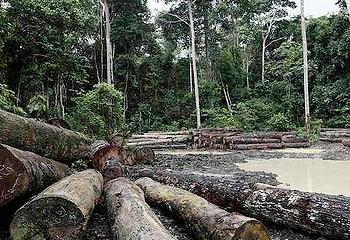
BRASILIA, Brazil, August 2, 2012 (ENS) – Deforestation of the Brazilian Amazon is slowing down according to an analysis of satellite images released today by Brazil’s National Space Research Institute, INPE.
Environment Minister Izabella Teixeria said the slowing trend in deforestation is a result of strengthened enforcement efforts and monitoring initiatives by the Brazilian government, including renewed cooperation with national intelligence agencies.
Data from INPE’s Real Time Detection System show that across the country’s Amazon region there was an estimated 23 percent reduction from August 2011 to July 2012.
An area of 2,049 square kilometers of forest were cleared during this period as compared with 2,679 km2 the previous year.
In the last four months, the reduction in deforestation was 50 percent, compared with the same period in 2011.
“This is a great result, which makes us want to work even harder to tackle illegal deforestation,” said Teixeira.
In certain critical states there was even less forest cleared during the same 12 month period.
The new data show a decrease in deforestation of 67 percent in Brazil’s northeastern state of Maranhão; 45 percent in Amazonas state, located in the northwestern corner of the country; and 42 percent in Brazil’s southwesternmost state of Acre as well as in the northern state of Pará.
Yet in the northern state of Roraima the satellite data show a 218 percent increase in deforestation over the same 12 months.
Teixeria announced that the municipalities of Alta Foresta and Santana do Araguaia have been removed from the ministry’s list of priority areas for prevention and control of deforestation for their good performance in 2012.
The minister praised municipal managers who are increasingly sensitive policies to combat deforestation in critical areas. “At first they complained,” she said, “but now they seek the ministry to know what steps to take to reduce deforestation.”
On the other hand, the municipalities of Anapu and Senador Jose Porfirio have been added to the list of priority areas for prevention and control of deforestation.
Dr. Carlos Nobre, secretary for research and development policies and programs at the Ministry of Science and Technology, said, “Lasting reduction in deforestation requires more than enforcement and control. This is why the Ministry of Science and Technology is working on a strategy for a new economic model for the Amazon.”
Some R$100 million (US$48 million) from the Amazon Fund will be made available in the coming weeks to support innovative projects utilizing sustainable resources in the Amazon, Dr. Nobre announced.
He said his ministry is working in partnership with the Brazilian Agricultural Research Company, Embrapa, to develop new standards for sustainable agriculture with a focus on productivity gains.
Teixeira explained that data from INPE’s Real Time Detection System, DETER, is used to analyze trends in deforestation. She explained that consolidated annual rates are measured by a different system, the Amazon Deforestation Monitoring Project, Projeto de Monitoramento do Desflorestamento na Amazônia Legal, or PRODES. These results are usually announced at the end of each year.
“We can not say yet that deforestation fell, but there is a clear trend of decrease to be confirmed by the System PRODES responsible for the official rate of deforestation in Brazilian Amazonia. This indicates that we are on track,” said the minister.
DETER can measure clear-cutting and forest degradation in areas greater than 25 hectares, about the size of two and a half football fields.
Deforestation in areas less than 25 hectares are being addressed by intelligence-gathering activities conducted jointly by the Institute of Environment and Renewable Natural Resources, or IBAMA, the Federal Police and the Brazilian Intelligence Agency.
“The action of the loggers’ is increasingly sophisticated,” said Teixeira, “to cut the forest even in the rainy season in an attempt to circumvent the supervision of IBAMA. Therefore, the operations in the areas identified by intelligence began in January this year, anticipating the actions of offenders.”
In early 2013, the Brazilian government intends to launch a new satellite carrying more advanced technology to identify smaller areas deforestion.
This will make it possible to take preventive action, said the minister, tackling deforestation at an early stage or even before it occurs.
But Greenpeace warns that illegal logging is still driving destruction in the Amazon. The environmental group, whose Brazilian chapter works to halt illegal logging in the Brazilian Amazon, alleged in April, “The implementation of governmental programs to promote sustainable forest management plans in the region lacks investments and is contaminated by corruption inside environmental agencies.”
Copyright Environment News Service (ENS) 2012. All rights reserved.
